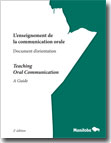Contents on this Page
French – English Program
Oral Communication
In an increasingly multicultural society, language competencies and intercultural understanding are an essential part of being a world citizen. The importance of learning another language is explored further in the following articles:
- The Added Value of Learning Another Language (
 149 KB)
149 KB) - Learning Another Language: Manitoba's Renewal Strategy (
 460 KB)
460 KB)
 The document, Teaching Oral Communication: A Guide is intended to provide a new focus for the teaching and learning of French in Manitoba with an emphasis on oral communication, in essence, the foundation for all learning of an additional language. Its goal is to illustrate student expectations for oral proficiency while guiding instructional and assessment practices for teachers. This document also outlines profiles for communication, themes, acts of communication, grammatical content, different learning situations and strategies to guide teachers to achieve the outcomes of the profiles.
The document, Teaching Oral Communication: A Guide is intended to provide a new focus for the teaching and learning of French in Manitoba with an emphasis on oral communication, in essence, the foundation for all learning of an additional language. Its goal is to illustrate student expectations for oral proficiency while guiding instructional and assessment practices for teachers. This document also outlines profiles for communication, themes, acts of communication, grammatical content, different learning situations and strategies to guide teachers to achieve the outcomes of the profiles.
Begin with the End in Mind
There are two main objectives for oral communication:
- Students listen for meaning and demonstrate an understanding of the communicated message.
- Students speak to communicate ideas and to interact with others.
Methodology
How does one teach to achieve these objectives for oral communication?
Current research suggests that teaching French is most effective, engaging and inclusive when a balanced literacy based approach is used. This approach supports increased language proficiency. Teaching methodology follows the cycle of speaking-reading-writing, with a particular emphasis on oral communication. The literacy based classroom is interactive, differentiated and supports language development in both the first and second language.
The balanced literacy based approach, modeled in the video clips below, shows the teacher how to put this methodology into practice. Refer to page 24 for the written explanation in the Teaching Oral Communication: A Guide.
| MPEG4 Format |
WMV Format |
|
|---|---|---|
| Oral | ||
| Student | 94 MB | 129 MB |
| Workshop | 88 MB | 113 MB |
| Reading | ||
| Workshop | 251 MB | 276 MB |
| Writing | ||
| Workshop | 167 MB | 180 MB |
Parlons secondaire
The goal of the Parlons secondaire video is to illustrate activities for Grades 9 to 12 that encourage oral communication in the classroom. The video demonstrates strategies that target everyday communication and support the balanced literacy approach to teaching French. A summary of each learning situation is found at the end of the modelled activity.
I Love French Class
The video, I Love French Class, provides a perspective on the shift to the balanced literacy approach that Manitoba Education has made. The video illustrates the methodology in action and it also provides testimonials from teachers, students, parents, and administrators as to the success of this approach for student achievement.
I Love French Class ![]() 123 MB)
123 MB)
I Love French Class ![]() 75 MB)
75 MB)
How should students from Grades 4 to 8 be able to speak in French?
Profiles for Oral Communication Grades 4-8
The Teaching and Learning Profile for Grades 4-8 summarizes the expectations for teaching methodology and describes student outcomes for oral communication. This description, accompanied by videos clips, serves as a model of student achievement at the end of Grade 8. An example of a completed assessment grid is provided to demonstrate for teachers the performance level of a particular student and how to provide descriptive feedback.
Student Video Clips - Grade 8
Nat
 Video in MPEG4 Format
Video in MPEG4 Format ![]() 24 MB)
24 MB)
Video in Windows Media Viewer Format ![]() 8 MB)
8 MB)
Assessment ![]() 1 MB)
1 MB)
How should students from Grades 9 to 12 be able to speak in French?
Profiles for Oral Communication Grades 9-12
The teaching and learning profile for Grades 9-12 summarizes the expectations for teaching methodology and describes student outcomes for oral communication. This description, accompanied by videos clips, serves as a model of student achievement at the end of Grade 12. An example of a completed assessment grid is provided to demonstrate for teachers the performance level of a particular student and how to provide descriptive feedback.
Student Video Clips - Grade 12
Leroy
 Video in MPEG4 Format
Video in MPEG4 Format Video in Windows Media Viewer Format
Assessment
Amanda
 Video in MPEG4 Format
Video in MPEG4 Format Video in Windows Media Viewer Format
Assessment
Assessment and Evaluation
How does one assess student proficiency in oral communication?
The profiles, accompanied by an assessment grid, guide assessment for, and, of learning and present the criteria with which to evaluate oral communication. The student clips video illustrate the expected performance levels. The completed assessment grids also provide an example of how to provide feedback for assessment for and of learning.
Please see pages 26 to 32 of the Teaching Oral Communication: A Guide.
The following documents support teachers in the assessment and evaluation of oral communication and provide templates of the assessment grid.
- Assessment - Assessment Grid
(  159 KB)
159 KB) - Assessment - Assessment Grid
(  17 KB)
17 KB) - An explanation (in French only) of terms used in the assessment grid for oral communication
- L'accent tonique

- Le rythme

- Le débit

- L'intonation

- La prononciation

- L'articulation

- Conclusion - La prononciation et l'articulation

- Les crédits

- Reference Sheet for Teachers: Suggestions for Descriptive Feedback
(  783 KB)
783 KB)

















